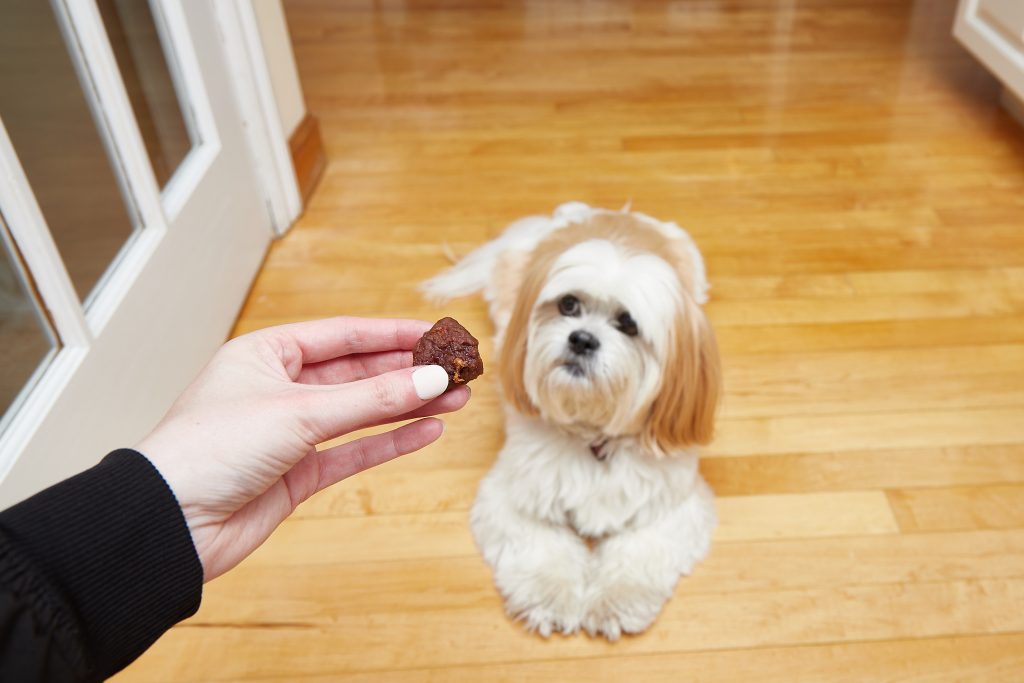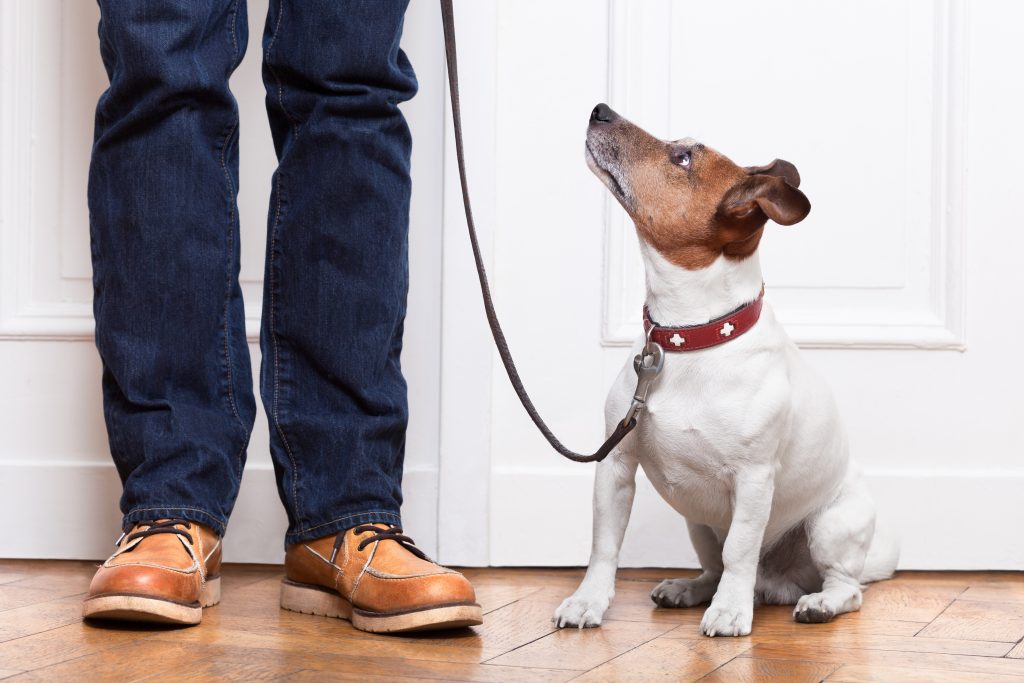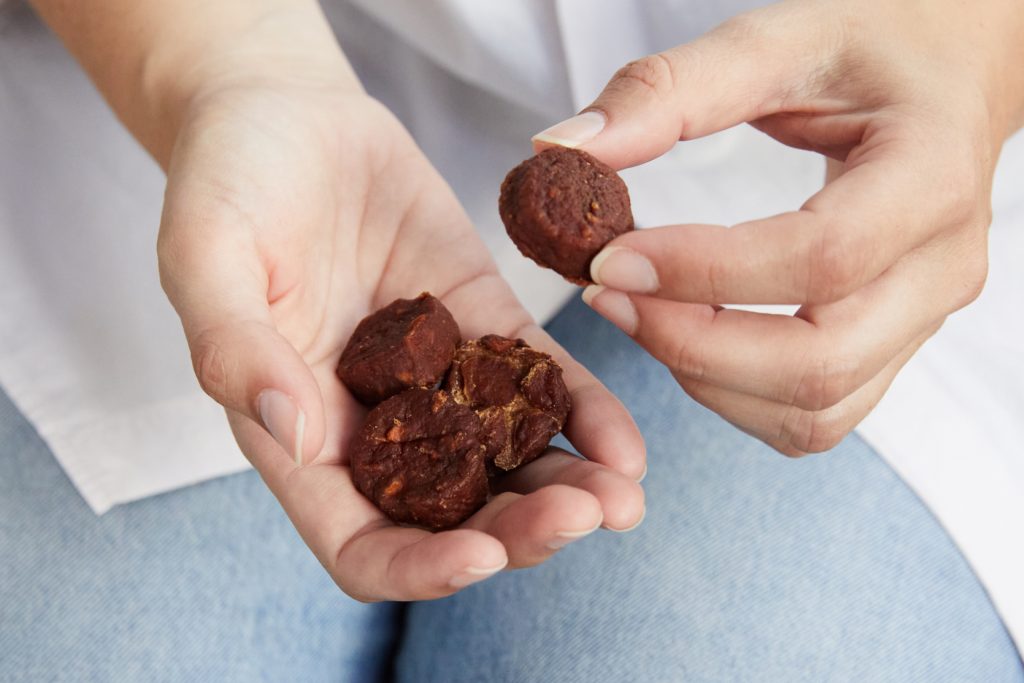Sit. Stay. Come. It all seems so simple, right?
A well-trained pup makes life much easier, but it’s important to remember that it may take some time to get there! And with a little research, you’ll notice that there are a few different styles when it comes to obedience training, all with different underlying philosophies.
So, how do you choose between them? As you learn about the styles, one might “click” with you over the others. Or, you might choose to combine styles as you find what works for you and your pup.
In this article, we’ll explore the world of positive reinforcement training, and how you can use the techniques to teach your dog.
Want to jump ahead? Use the links here:
- Introduction to Positive Reinforcement
- Common Dog Obedience Training Techniques
- How to House Train Your Dog
- How to Leash Train Your Dog
- How to Crate Train a Dog
- How to Train a Dog to Stop Barking
Introduction to Positive Reinforcement

First, what is positive reinforcement? Simply put, it’s a dog training philosophy that uses rewards in exchange for correct behavior. Whether you use treats, toys, or even just verbal praise, your dog quickly learns that when they do a certain behavior, they get a reward.
Keep reading and we’ll dive into what you need to know.
Select the Reward(s)
First, you’ll need to think about what kind of reward you want to use — ideally something that will truly motivate your dog. If they don’t care about the toy you’re using or don’t love the treat you’re offering, the techniques won’t be as effective.
Many trainers also recommend creating a “hierarchy” of reward options, depending on how challenging your training routine is. For example, if you’re just practicing something they’ve successfully learned in the past — maybe a simple “sit” at home — you can offer a low-value treat as a reward. But if you’re teaching them a new or really challenging task — such as staying put when the doorbell rings (so exciting!) — try rewarding them with a higher-value treat.
Treats
If you’re using treats, you may need to experiment with what works for your pup, including different flavors or textures. Break larger treats into small pieces, and be mindful of how much you’re feeding your pup — you may need to adjust meal amounts before and/or afterward to make up for the extra calories they’re getting. It’s also smart to couple the treat reward with a verbal reward. Praise your dog with a consistent phrase like “Yes!” as you offer the treat.
| Tip: Pups love our 100% Organic Chicken Apple Sausage Bites! Full of delicious ingredients like real chicken, apples, and pumpkin, they’re high in protein and picky-eater approved. Plus, they’re easy to break apart — making them a great option for training. |
Toys and/or Play
Toys, or incorporating play into your reward, are also very effective. When you’re at the dog park, for example, try keeping a ball or frisbee behind your back while you give your command. When your dog does the desired behavior, throw the item and begin to play again.
Affection
Finally, you don’t even need to have any physical items on-hand to use positive reinforcement techniques in your dog training. Many pups are happy to get rubs, pats, and verbal praise, especially if it’s a task or behavior they’ve already learned.
Stay on Top of Timing
Timing is everything when it comes to obedience training, and especially so for positive reinforcement. The reward should happen immediately after the desired behavior so that your pup can easily associate the two things: “If I sit, I get a reward!”
If you wait too long and reward your dog after they’ve popped back up from sitting, it’s not as clear.
You’ll also need to reward your dog often when you’re first training a new behavior. Training is all about repetition and consistency, and the more you practice and reward your dog for good behavior, the faster they’ll learn. Once your dog reliably does what you’re asking, you can ease up on the rewards so that you’re just offering them intermittently, or switch from offering a treat to offering verbal praise.
Combine With Dog Training Hand Signals or a Clicker
“Clicker training” is often grouped with positive reinforcement training, as it follows the same philosophy. With this style, you carry a small device that makes a clicking sound when you press it. When your dog is doing what you want, you click the device and then follow with the reward. Your dog will begin to associate the click with the behavior, so it’s even easier to get the timing perfect.
Many owners also find success using dog training hand signals, which can be either combined with or in place of verbal commands. Hand signals are usually easy to teach, as dogs are very tuned into our body language. There are many standard hand signals — such as holding your palm out next to your body for “sit” — but you can also make up your own! You can then couple the hand signal with your reward to make your obedience training that much more successful.
Be Consistent
Finally, it’s important to be consistent in your training. Since you’re teaching your dog to associate one thing (a certain behavior) with another (a reward), there can’t be any confusion in between. Make sure everyone in your family uses the same commands, understands the importance of timing, and helps with practicing and repetition every day. Enthusiasm also goes a long way in helping your dog learn!
Common Dog Obedience Training Techniques

Now that you know the basics, let’s explore some of the most common training opportunities. Combine what we’ve outlined above with the tips below for your best chance at success.
How to House Train Your Dog
House training (teaching your dog to poop and pee outside) is usually first on the list for new puppy owners. Here are some of the best tips, along with how to use positive reinforcement techniques to solidify the behavior:
- Take your dog outside often, especially after sleeping, eating, and drinking. Aim for every two hours, if not more.
- Pick a consistent space. Familiarize your puppy with the space, and don’t rush the process; give your pup ample opportunity to relieve themselves.
- Try a command. Select a simple verbal command or hand gesture to associate with the potty break. As soon as your dog starts to go, for example, you can say “Go potty.”
- Offer the reward immediately. As soon as they’re finished, reward your dog. Don’t wait until you bring your dog back inside, as they’ll have trouble associating the behavior (peeing outside) with the reward.
How to Leash Train Your Dog
Another important thing to teach your dog is how to walk with a leash. Believe it or not, puppies don’t know how to do this right from birth! Whether you’re teaching your puppy the basics of walking on a leash, or you have an older dog who needs help with loose-leash walking (not pulling, that is), you can easily use positive reinforcement techniques to help along the way.
Here’s how:
- Introduce your dog to the leash in a safe, enclosed place. Start with your backyard, for example, before heading to a busy park. Attach the leash, but let it drag on the ground at first while they get comfortable with it on.
- Start slowly. Hold on to the leash loosely at first, and begin with some slow circles around the yard. Offer a treat as a reward every few steps, holding it close to your side. This ensures your dog learns that walking close to you leads to the reward.
- Practice, practice, practice. As your dog gets better at walking on the leash alongside you, offer the reward every 10 steps, then every 20 steps, and so on. When you start feeling more confident, try practicing in a slightly more busy area. Eventually, you’ll be able to phase out the treats in favor of verbal praise as they walk calmly next to you.
- Introduce a “recall.” In training terms, a recall is simply a way of getting your dog’s attention when there are distractions around. For example, you can use positive reinforcement techniques to train your dog to look at you when you say their name, as a way of calming them and ensuring their attention is on you — not the upcoming distraction.
How to Crate Train a Dog
Crate training your dog from an early age is a good idea, even if you don’t anticipate regularly using a crate inside your home. If you ever have an emergency and need to transfer your dog safely, knowing that he or she is already comfortable inside a crate will save you a lot of stress. The good news is that most dogs instinctively seek out small, enclosed spaces. Most of the time, crate training is easy once you understand the basics.
Here are the steps:
- Introduce the crate. Leave the door open and allow your dog to approach the crate on their terms. As he gets near the crate, toss him a small treat. If he steps inside to investigate, throw him another one. Remember your timing: you want him to understand that entering and being inside of the crate is what leads to rewards!
- Use a command. Try incorporating a command, which could be as simple as “Go to your crate” or “Go to your room.” Toss a treat into the crate and when he goes to get it, give him lots of verbal praise.
- Repeat. Reward and praise your dog as he gets used to being around and in the crate, so he associates it with positive feelings. Once he’s comfortable, you can try closing the door gently. Make sure to use plenty of praise!
How to Train a Dog to Stop Barking
Barking is one of the ways your dog communicates, whether it’s to get your attention, to express an emotion (like loneliness or anxiety), or to protect their territory. A little barking is normal for a pup, so don’t expect to train your dog to be totally quiet at all times. But when the barking gets excessive, you may want to add it to your training list.
While your instinct may be to use a “Quiet” or “Stop” command while they’re actively barking, sometimes this leads to unwanted reinforcement for the noise. If you react while they’re barking, they’ll think they’ve done a wonderful job getting your attention!
Instead, use positive reinforcement techniques to:
- Reward the quiet. If your dog is barking for attention (and there’s not an actual problem that needs to be addressed), try ignoring them. Be patient, and wait until they stop barking. Then, reward your dog when they’re quiet by turning your attention back to them.
- Switch the cues. Consistency and routine are great, but can lead to your dog getting overly-excited when they know dinnertime or a walk is coming up! If there is a specific cue that excites your dog, such as picking up their leash, put it back down when they start barking. Once they’ve calmed down, try picking it up again. Reward your dog if they stay quiet; if not, repeat until he starts to understand.
Train with PetPlate

Looking for a great training treat? Our Organic Chicken Apple Sausage Bites are made with 100% human-grade ingredients, so you can feel good about the rewards you’re giving your pup. No fillers and picky-eater approved, add them on to your next delivery of fresh-cooked PetPlate and you’ll have everything you need for a healthy, nutritious diet for your pup.

